In this page I will blunder through showing you the things I have built over the years.
Lazy B
I attended my first 2 BHPC meetings at Milton Keynes and Eastway. At the time the only things for sale were the Trice and the Burrows Windcheetah kit. The first thing I bought was the Speedy kit. As it consisted of a bag of raw aluminium castings. I started building it at a model engineering evening class. It will be some time before it appears again on this page. At Eastway I rode the Bean Trainer. It had short pitch chain and home made gears but it looked possible to make something like it. A friend had a Bickerton. Strangely, they were quite popular at the time. The frame layout was quite like the Bean Trainer. At the time I was an Art Therapist living in at a big bin near Letchworth (if that was a question, it isn’t). Bickerton were at Welwyn Garden City and I persuaded Mark Bickerton to sell me a bit of their rectangular tube. The first bike used that, the Speedy seat and the rest of the Bickerton components to make a recumbent. Note the original non-grip white Michelins and SA 3 speed. A couple of the pics are from a slightly hilly TT with the Hitchen Nomads. Must have surprised the coach passengers.
At some time around here I added my first fairing. Miles Kingsbury sold me a Coffee Bean nose fairing which was bigger and smoother than the Parrot fairing used on The Beanbag. the bag was attached with velcro (Andy Forey please note) and stretched back to a structure at the rear. I don’t appear to have any pics but I rode it as a private TT in the Hitchen Nomads weekly 10. They set me off first, assuming I would be slow. Despite being much undergeared with the SA 3 speed, I got back about 20 mins later, to much shaking of mechanical stop watches. it wasn’t long after my first TT and I had gone from a 28 down to a 26 on my beloved Chas Roberts tourer, which soon got stolen.
About this time I changed the rear wheel for a 400A (un0btainable now) and added derailleur gears and large TA triple fought over with Mark Silver under a table at one of the old Freewheel sales. The chainstays were made from scrapped NHS hospital curtain rails.
I replaced the ‘Lobster’ bars with underneath bars. It took some weight off, improved the structure on a flimsy bike and simplified the cable runs. These pictures were at Kimbolton and Eastway. Note the snazzy gear in the latter, also from a Freewheel Sale.
About this time I moved to South Harrow to do an IT course (no living to be had in Art Therapy).
The faired picture is in Harrow. One of the nicest looking versions, with the nose extended back and a Correx floor. The rather transparent fairing was described as a ‘full body condom’.
This may have been Munster or Emmen. It shows the Correx floor and wheel disks. No real rear dropouts, just holes in the stays. Hanger bolted into the rail section. Probably Ian Sheen’s Speedy back wheel on the right.
Velocino
About this time I made my Velocino from Bickerton spares. The original came out in the 1930s. The parts for mine crept out from under my bed. It is a little hard to start but surprisingly pleasant to ride. The front tyre is fat and lightly loaded so it rolls quite well over small kerbs. It was the subject of my early article ‘Knit Yourself a Velocino’

This triggered some other effort including Steve Donaldsons Lettuce Sport, made of wood, with a steering stick like a boat tiller. These pics show Steve and Julian ‘The Appalling’ Higgs racing down Morecombe Prom at Cyclevision.
These are a production bike by ‘Travel’ at the Europeans, Munich and Steve Donaldson’s ‘The Wee Bike’ at Lancaster.
Steve Pearson and gNick Green on the Velocino, plus Badass rear steer at Eureka ’94. Actually, I think it is more a unicycle with stabiliser.
Back to the Lazy B, my Bickerton monster. As you can see in the pic at Welwyn Track, the bag necks in a bit after the nose cone. It ran out of steam a bit over 30mph. Could have been fault of that helmet!
This is Eastway. Miles Kingsbury, Andy Pegg, Slasher Slade, me, Roger Akres and Richard Ballentine
This one is after I moved to Chertsey, with bigger wheels. It had rear dropouts I machined to take further curtain rail back to a rear post. I changed the seat for a mesh one, stretched tight by lacing on the back. Lighter and more comfortable than the Speedy seat. The fairing also changed so it went outside the nose cone and laced tight at the rear post.
About this time the frame broke through the head tube. Must have been like a cartoon as the bike ground into the road. The head tube was welded in, unlike the Bickerton and had a good headset, but it was still a weak point. I made a substantial lug which inserted into the rectangular tubes. I changed the angle of the tube at the head so I could fit inboard gears, out of the airstream. The fairing also changed, with a sprung rear post and cut upwards more, to reduce side area. Photo on the right from Hetton. Steve Donaldson tried it there and coveted. This was pretty much the bike that became Oscar 1.
The Shopper
Up to this time I was riding the chassis to work, but changing it from racing to commuting form after each race was getting a bit difficult. Hence ‘The Shopper’ was born. At first it had 451 and 622(700) wheels. The frame was made from a Raleigh 20 Shopper, with extra bits made by me at my class and with the brazing gear I bought with Mark Silver. The seat is the same design as the Lazy B. It was much influenced by the ‘High Bike’ fashion then popular in Europe. Note ‘Wonderlights’
Here are some construction pictures.
Here is a later version with 520 and 622 wheels. The brazed on front bit had broken off, so I added a substantial internal lug. Not quite as docile but surprisingly quick.
The Speedy
Next we go on to my Speedy at last! It was built racing style with 559 and 451 wheels. It was the first Speedy to have a Shimano cassette drive and indexed gears. I spent ages powerfiling excess metal off the lugs. The brake lever has holes drilled in tribute to Alf Engers. I asked my mum to make me a seat cover in red, so she made it in blue with the zip in the wrong side.
Later it got a racing Speedy fairing.
The Missionary
There were some other oddities about this time. This is ‘The Missionary’. You can guess how it got the name. I had been riding fairly radical TT bikes and seen a prone at Yreka/Mount Shasta. The Missionary was made from a crap old frame and a half, some gas pipe and a very crude foam hip support. It weighed a ton. Still hung on the workshop wall. It relies entirely on the elbow rests. No shoulder/chest rest.
It was a pig! The cranks were so far behind the back wheel, it left the front lightly loaded and the moving leg mass shook it around. In a TT position you don’t realise how much weight your back carries until you support your upper body on forearms. I don’t think I will ever do another prone, but if I did it would have 2 x 700 wheels with cranks through the back wheel driving a cross drive, probably behind the wheel and hub centre steering at the front. Oh, and shoulder supports. Mr Obree has a lot of the dynamic elements right, with the cranks above the back wheel, but I don’t believe it is possible to make a shape with the right camber for a prone. I spent a while photocopying and cutting out images of Eivie II and can’t make nearly as good form.
The Sonic
Talking of TT bikes, this is my Sonic. I designed it rather despite Helmut Burns who made it. It has a Burrows Monoblade and Blade seat post, with an extreme variant of the Burrows/Giant frame design. It isn’t short. I wanted to stretch out as I had seen Fast Freddy doing. Mavic Zap changer is a little too sensitive, but otherwise excellent. It still ticks OK after all these years. I did my best 10 and 25 official TTs on this bike. I think it was a long 24 and 1:02, but I didn’t get much chance to use it. The local flat course was abandoned due to traffic. I bought the wheel rims (tubs) from Steve Hed at White Bear Lake. I was there for the WHPSC in ’93. The rear hub is a special from Hope with 12 and 6 spokes. That’s right 18! I made the front hub. It has double ended spokes and spoke nipples protruding through the shell. I had drawn it, then Steve Hed showed me a similar one he was working on. The carbon Flite Titanium saddle is very comfortable. It is very smooth and both the top and the titanium rails can flex. The same cannot be said for the monoblade which is tooth jarring. If a medium height TT fan would like to try it, let me know.
Here is the hub I made for it.
The Black Hack
This was quite a productive period. The next bike is the Black Hack. It is a ’50s Nervex racing frame with lots of mods. These days it’s a bit of a “Grandfather’s Axe” having had some tubes replaced. It started with a bike I bought with SA 5 speed gears. It was too big, so I bought the frame at a Ripley jumble. I didn’t like the SA much after it catapulted me over the bars when riding from a set of lights. Now it has a Sachs Super 7, Lightspin dynamo, Standlicht LED front as well as rear and tri-bars, which are worth a gear on the flat. It has Kojaks which seem to roll well. This is the main bike I will use if I get back to commuting. In this pic you can see the original highly raked pencil forks. Handled great and rode very soft until I rode it into the back of a truck. The steerer was S shaped. I asked Mark Silver if he had anything similar in his collection. He didn’t get back. Turns out he put the forks on his commuting hack and may still be using them now. I used some spare Carlton forks, rethreaded, but it didn’t feel good until I raked them more.
Oscar
OK – about time for ‘The Big Issue’- Oscar. I wanted to build a hard shell for my streamliner. I based it on the LazyB 2 chassis. Monocoque bikes were uncommon in ’93 and the bike tucked me and the components in quite tightly. I used a program called FLoft, (Superceded by Loftsman) written by the Excellent Peter Garrison. Mike Burrows had used it for one of his racing Speedy shell designs – with some help from computer literate persons. It is a conic lofting program. Peter designed some great aircraft with it. It lets you define a curve with 3 points and a curve factor. They are strung together and can be modified so the radius of curvature forms a continuous curve with no sharp changes. The air likes these kinds of curves. The first aircraft to be designed this way was the NA P51 (Mustang) which was a generation better than the Spitfire in range on a lesser engine. I guess I could consider the physics, but on a normal level, air likes to follow these smooth continuous curves. Once you have good shapes, a major factor is minimising surface area. Oscar was always going to be too short to be a record bike, but went well and handled pretty well in cross winds, probably due to the rounded shape.
From Floft I got some plots done. I think James Murphy helped me with this. I traced them out onto ‘Jabalite’ (Styrofoam) in 1 inch layers. I cut the shapes with a hot wire cutter, noting reference points and eventually assembled them with PVA, keeping it away from the edges so it would sand well. After that I started roughing out with a hardwood coat hanger with Eureka wire stretched across by what looks like a Hofner machine head. Power was supplied by a thyristor mains controller and an ordinary battery charger.
The images show I have started to carve the front. I spent ages trying to get it right. I had to hoover my garden at night to get rid of all the foam bobbles. Eventually it got a couple of layers of glass and lots of filler, but still wasn’t good, so I called in a pro. Tim Middlehurst of Canoesport. He made rather radical racing canoe paddles and was a good racer himself. He worked on the plug at Timsway Yard, Staines, where I was later to work. It got named ‘The Egg’ there. I named it Oscar after Oscar Egg, the Swiss cyclist who experimented with fairings. Tim got it all smooth and made a 4 part mould. He made the first Oscar shell, with some some help from Janousek, who were doing the Oxford/Cambridge boats at the time. They gave him some thin Nomex. However, Tim did not have vacuum, so the shell wasn’t well consolidated.
OK – here ’tis at first race a Hernia Hill. No foot doors so I needed help to push off from the side wall. It was obviously quick. This shows me racing Nigel Leaper in the Leaper Low. He was a bit like me – no special athlete but a good designer. His bike was better. I think Steve Donaldson in a Wasp had followed my impetuous sprints and beat me, but it was a pretty good debut!
Here are some more pics of oscar 1, as it became.
Oscar 2
Oscar 2 was aimed at getting a bit lower to decrease drag and adding front suspension to increase cornering speed. I made most of the suspension for the Lazy B but it wasn’t good. I did a lot of work on it, including reference to Tony Foale. At the time my cousin Barry Lytollis was looking at suspension ideas for his Guzzi Le Mans. The initial idea was to make an Earls fork, with a metalastic bush behind the wheel. A few sums revealed this would be very heavy, so I went for a leading link setup. I think the early probs were due to flex in the ‘forks’. I replaced them with CroMo steel.
Here is an early version of the Oscar 2 chassis.
At this time it had a Moulton size front wheel, with a caliper brake. Trail was adjustable. The rear forks were made from aerofoil CroMo. It had rear suspension too, but I could not get it to work without the rear (continuously rotating) chain catching things, so it was locked out. When it came to getting the shell to fit, the front suspension clashed with it, so I reversed it, making it trailing link. To avoid brake dive I used a narrowed Sturmey brake hub (Thanks Miles Kingsbury) with a torque link to push up on the forks. Various different suspension media were tried. I think I ended up with windsurfer mast step rubbers. I found this version of the chassis delightful. The suspension was quite soft and floated over road bumps, but it didn’t dive under braking. Not everybody liked it. The steering was a bit sensitive, but I rode it to work quite a bit and got on fine. I sold this chassis some years back, but I wouldn’t mind buying it back for a price as modest as when I sold it. Last I saw the suspension was the wrong the wrong way, so the trail would be wrong.
Tony Shingler said he would return it to me, but I can’t contact him. I planned to re-use the suspension on Oscar 3. It could have a rod through the steerer. The crossover drive would be hinged and could move to keep the chain length constant.
This is Oscar 2. It has the new chassis, with trailing front suspension and is a bit lower. The shell is a single thickness glass/vinyl ester shell. The vinyl is between polyester and epoxy. in properties. It is very flexible and hence more resistant to cracking. The screen and head fairing, made of Karrimat foam, seemed to make it faster, but I don’t have figures. Didn’t scan well. I may have another go.
This is the underside of the same bike. You can see the front suspension and what still looks like quite a nice profile. As a circuit racer it was made as short as possible, but it looks OK as far back as the shoulders. Also a top view.
Here is a racing pic from Hernia Hill
Faired Speedy
Now for the faired Speedy. This picture was taken outside The Masonic Hall in London. I liked the contrast with the TVR. Ian Sheen set up a deal with a film company. They were doing a ‘futuristic’ advert for a London college, which was shown in cinemas. Ian rode my Speedy as his was covered in adverts. I rode Oscar, presumably 1 as it had no screen. They gave us little Cinelli style head fairings. Oscar was not designed to be a commuter. It would lose chains in the stop and start needed for the filming. I would find myself coasting around Soho trying to get them sorted out.
Here are 2 more views. The underside views of Oscar 2 and The Speedy were done when I was looking into using Vortex Generators to improve the flow over wheels, windows etc. I got stuck with the idea when I couldn’t find a rolldown course to test any changes.
The Speedy also had another claim to fame. There was a demo event at Manchester Velodrome. The Burrows rode whatever was the latest. Andy Wilkinson road his end to end record setter. Ian Sheen rode his much stickered machine and Andy Pegg rode mine.
I rode The Speedy to work a few times. It was good for 30mph quite easily, but the view was terrible. The screen misted easily and was so shallow any dirt obscured it and sunlight ahead made it very difficult.
I only raced it twice. Once was on the infamous Darlington hilly time trial. It took a while to get up the first big hill, but it descended like a dive bomber with no dive brakes. The course has dry stone walls beside the road. Going past gates put me right across the road. The very light steering scared me. I gripped it too hard and was frightened to use it in case it got into an oscillation and turned over. The other race was at Eastway, after I had agreed to sell it to Dave Cormie, to prove it worked. I wasn’t used to handling a trike on the corners, but it went pretty well. At the time I nearly emigrated to Spain to be with Carmen. In the end I didn’t go, but I wasn’t using The Speedy, so I sold it anyway. Dave only really wanted the chassis. He sold the shell on to Andy Harrington, who used it at Bentwaters. The shell was made for 451 front wheels and very low ground clearance. It looks a bit sad with 406 wheels.
Here is the page for the handbikes. http://wp.me/P2Fz9o-85
Hocus Pocus
Now we get to Hocus Pocus. I had been failing to make a new Oscar for a bit. I restarted racing on The Shopper, but wanted something better. Mike Burrows had made B2 with hub centre steering. I tried it and liked it better than he did, despite being as floppy as a very floppy thing. Possibly a very floppy THING.
I had the idea to do a SWB bike using hubs centre steer (HCS) SWB bike. My reasoning is quite different from Mike’s. Conventional SWB bikes have a curved part with a head tube through it in the most stressed area. I put a chassis member each side of the wheel and a light one over the top of the wheel. The whole structure is very strong and could have been made much lighter. Here is the hub I made.
The hub has a kingpost in the middle. The inner hub does not rotate. The bearing the wheel rotates on are the big ones with blue seals. The head bearings are conical type and sit in the inner hub, just inside the rolling bearings.
When I started I was going to use remote steer, so some kind of hub brake was required. Here are the brake components including the top hat shape brake drum, chromed on the outside and the various other components that made the brake work.
At this stage I was still using a Sturmey backplate. The axle has a torque arm which serves 2 functions, It resists braking force and also allows fine adjustment of head angle. The other arms operate the brake. The drum screws on with M5 cap screws, but 2 are replaced with gauge pins. Everything was machined together and it isn’t possible to put the drum back the wrong way.
I made a rough chassis from plywood, following my practice from the handcycles. The position was based on The Shopper, which was fairly aero and comfortable. The first version had remote steer bars below the chassis. Here is Neil Flemming riding it at Welwyn. It was very flexible and horrible to get started, but fine once moving. Note special Schwalbe front tyre. It rotted with UV before I got to use it.
Here is a slightly later version at Curborough with Pete Cox at the wobbly helm. The bars are still remote, but above the chassis, and they are more substantial.
Here is the setup on the Mk 2 rig, with remote steer. The seat was moulded off a plywood seat I bought in Holland. My first go at vac moulding. Not pretty but light and strong.
Rosie helped me out with the work.
I did some work on vacuum bagging. I have a selection of Nomex cores from when I worked for British Airways. For aerospace use, the cores have a limited life. They were clearing out as the CAA are not happy if there is outdated materials on site. I had to hire a van. The seat you can see is my first effort. It isn’t good but it is quite light and strong. I have vac but I don’t have an oven. Mike Nelthorpe (HQ Fibre Products and builder for Mike Burrows) wasn’t very used to using glue film with Nomex, so we did a few experiments. We made an number of samples. I worked at the National Physical Laboratory and persuaded one of the scientist to do test on the samples on an Instron machine. The results follow. I will put in a better copy when I find it. The Instron machine supports the sample at 2 points and presses down between them. The lower 2 specimens had 1 layer of carbon each side, 10mm Nomex. One is with glue film, the other with wet resin rolled on. The upper 2 are the same with 2 layers, the top one with glue film. The line of deflection is nearly flat and reaches the highest load. It broke in a different way. The inside of the bend collapsed as the core was crushed. For all the others the outer skin broke first. If you look at the one below it, the trace has a condsiderable curve and flattens out before it breaks. My guess is that this reflects the poorer skin bonding.
Here is Silvie Nelthorpe laying up one of the side members. She is overlapping pre-preg
Here is the 1st layer with the Nomex core under vacuum bag and as it came out, with the metal components I made.
Here is the second stage. Silvie has assembled the carbon for the other side. A glue film will be put on the panel Silvie is moving, then the 1st part on the left will be assembled on top of it, vac’d and heated to complete the middle component of the machine.
Here it is being assembled with the blue glue film, and an example of the Nomex. It is a honeycomb of resin impregnated paper. It holds the skins in place so well it behaves almost as if the panel were solid.
The plywood version was assembled with M6 bolts which went right through the layers. Mike chose to use carbon tubes to emulate this. I don’t think it was needed as the Nomex is very good in shear. As I say, you can almost treat the panels as solid, unless there are peeling stresses. This one shows the reinforcing layers around the pedal axle.
Here is the bike as built up. It only took a couple of hours to get it this far. Everything was very well lined up. The green Michelin tyre came from a cycle jumble and did not last.
OK – here is the old git riding it at Hillingdon. A git is a pregnant camel! Presumably they are irritable. The front tyre is a Schwalbe special racing Stelvio sold to me by Hans van Vugt. The front number may be a slight bending of the rules, but at least it is really clear. I didn’t think a chainguard was needed as the frame extends in front of and above the chainwheel. I fit really closely into the bike.
The bike is incredibly rigid. No chance of bending the frame, though the lightly spoked rear wheel can make hand down starts difficult. You can see the side frames are narrower than the pedals but wider than the cranks. The BB is triangulated, supported by the side frames and the middle member. As above, many low bikes have a curved member over the front wheel. It tends to be flexible or heavy. This bike is built way heavier than it needs to be. A lighter one would work fine. The only downside to the hub centre steering is slightly limited steering lock. Not a problem for a racing bike. It is very easy to ride and brings a grin to the face of those who try it.
An early outing was at the 1st Jersey event. I was still getting used to it. Andy Forey rode it in the hill climb. We had to leave his bike behind, but that is another story. He had a good ride. It isn’t light, but the rigidity is good when you are going flat out.
I rode the TT. I hadn’t tried the course. Some corners were too sharp and some parts of the course too scary. I did better in the sports centre circuit, where I learned the bike landed fine after taking off on bumps. Also learned some cornering. The crit wasn’t good. Again it survived takeoff over speed humps, but some of them were in the corners and I didn’t push it. I fell off on a right angle bend where the steering was on lock. I would probably have got through if I was going faster. Got back on and cruised to the finish. Not a course for me. Here are some pics. I would credit them but I don’t remember who took them.
I think it was Fowlmead 2009 when Howard Yeomans asked to try HP. Howard is a far better rider than I have ever been or will be. I did really well in the ‘slow’ race. Me and Andy Forey on the Festina followed on with the group, but blew it apart after the first lap. He went on the right, me on the left. The start straight is an ascent. I held on to Andy for a bit, then got dropped and caught by John Coulson and Kevin Jenkins. I was the fastest on the descents and flat, Kevin on the climbs. Late in the race Richard Everett lapped us and I took up his slipstream, losing the other 2. Probably the best tactical race I have ever ridden.
As I recall, Howard was at the front of the unfaired class, dicing with Dave Tigwell. We rode like that for some time, Howard in the faster race, me in the slower. It suited Howard well as I delivered the bike and he could trun up on his motorcycle.
I decided to do some revisions. The shape of the underside was done that way to give enough stiffness for the wooden version to be strong enough. Not needed in carbon, so I ground it off flat and routed the return chain through it. I wanted a better shape to the side pieces. I designed the shape on Loftsman. A guy in the US generated a skinned model from it. Graham Sparey-Taylor machined the shape in foam. Mike Nelthorpe made a mould from it and installed the new shapes and covered in the underside.
Here is the bike up on the bench after cutting the underside. You can see the line of tape I followed.
Here are 2 tests with tail fairings. On the left is a Burrows Ratracer tail, which proved too small for me. The other started as the tail of the handcycle. It was modified to fit The Shopper when I was racing that. I tried working on it more to make a mould, but gave up. It was just too rough. I looked at this with Graham Sparey-Taylor who agreed to help me design a new one, but we didn’t get anywhere. I have some sheets of Correx to make a basic version when I get one of those round things.
I’m just charging the camera batteries to show how the mods came out.
Currently the bike is stripped down. There was a problem with the head bearing. Under braking I think the angular contact bearings exerted too much push on the head bearings. I am going to try normal bearings, which at least have the advantage of shields and should push less. Last time around, Mike N made me a carbon ’tile’ to replace the steel side plates. The steel side members around the front wheel will be replaced with Nomex honeycomb. The bars could be replaced too, but need to be adjustable as the current ones. The socket can be higher so they bars get in the airstream less.
Oscar 3
There was some slow progress on Oscar 3 before I ran out of steam. I made most of the metal bits some years ago. It is planned to be front wheel drive, rear suspension, lower and with various aero and operational mods. We had been talking about Howard riding it, but he has departed to another continent. I made a plywood chassis mock-up and bought a sheet of 25mm aerospace Nomex for the backbone of the bike, which I am scared to cut.
It is a semi monocoque, with the tub permanently fixed to the backbone. This is to reduce wheel rub. Also there are side members like HP either side of the front wheel, for the same reason and to make the chassis around the front wheel more rigid. The back end bears on another windsurfer mast base for suspension. The back of the seat is bridged to the steering head area in a way similar to The Wasp, but under the shoulder. It is quite tight in there and heavy and flexible in wood. It is intended to have a Varna head bubble, for which I have been leaning the seat back a bit. The seat is a new one for me, based on an available design which has more of a saddle tip at the front. This helps as the sitting position is quite upright.
This is an early version. The full loop around the rider was for tests, not for the final version.
Here is the full rear wheel enclosure and suspension. It has a modified Sturmey brake and is intended to minimise the amount of air the (disked) wheel moves around, in accordance with Matt Weaver’s theories.
These pictures were taken during testing at Reading in 2011. It was mainly for Howard to try, but he took better pictures than I did. The bike worked pretty well and was stable. l was unhappy with the steering, which was heavy and the basic seat. The top one shows what a tight package it is. It is a very old and tatty shell, probably the one I crashed at Leicester. The split has been changed. The top of the nose and the lid are combined in one. There is a horizontal panel inside which pulls back into a slot in the backbone. Should remove the trip line over the nose and be easier to handle.
The cause of the heavy steering was unexpected. There was some slop in the rear suspension bearing. When I steered, the back end flopped before the steering started working, after which it was OK. Also the chain tensioner didn’t work well. I replaced it with a single speed type which seems better. I changed the obsolete 7 speed for a splined 8 or 9, but I’m not convinced it is concentric enough.
Mike Nelthorpe made the new seat, but was unable to do what I wanted. I had asked for a pair of deep flanges to allow adjustment. He couldn’t do it that way so he made 2 additional flanges. I had hoped to save weight. Maybe the eventual solution is to have the seat made in 2 halves! meanwhile I will bolt on the flanges, but I must admit it brought me to a halt. I still owe payment to Mike. He has not chased.
There were quite a few little changes to give toe, knee and other bits of space. Could be the final answer will be an inner shell to hold everything in place, with big cutouts where needed. Nitroglycerine does it that way.
HPB
Apart from Oscar and HP, the other bike project is HPB. You may remember the Burrows B2, which I liked and he didn’t. Well, the hub had been with Paul Lowing, not used. It was agreed I would have it, as I liked the original bike. I planned to use HP type construction to remedy the flexibility. I have the wheel/hub and bought a HED deep front and disk rear wheels for it. I did some design, but didn’t get any further. It should be a good bike, losing the excess weight of HP and much more sculpted. A tail fairing that fits HP should fit HPB. This pic was taken by Andy Forey at the last Cyclevision, amongst a mass of Mike’s effluvia and a ‘Gate’.
That is about up to date. I need to add some more pictures but now I have to get going and build some bikes, when I get a circular thing.
Notso
A recent project is the Leaper Not so Low. I think Nigel Leaper made it in about 2001. I bought it from Nigel Sleigh a couple of years ago, for a bargain price. It is foam sandwich monocoque, with steel bits to hold the front drive works. Originally had a big transparent bubble, but nobody was found who fitted in without a hole in that. Still too small for me. Shawn Ballentine is the current rider.
04/05/22 – Notso has come a long way. Pilot now is Liam Goodman. Latest is a full head fairing and a rear wheel fairing is coming, Mostly sharing on Facebook. https://www.facebook.com/media/set/?vanity=100010218519559&set=a.468026706881276&__cft__%5B0%5D=AZXg6gnun0Dk7kADLyF7c5gdedhUtkwNsCjrJf5jjqVv5Dd7UjFEgSyMXZwVg3iEun7EH1Z6uBqGFIQ901ax-CmB0MGloueovu9BB9J82AoXZA&__tn__=-R.
There’s also the Trisled rail bike I have not documented here. https://www.facebook.com/media/set/?vanity=100010218519559&set=a.1136353516715255&__cft__%5B0%5D=AZXtvKfzfMUkEgoC3xEEiBe58bU0TwDCBpDfwd4c5RWrdxvYzPPrvG5NeKUmGe59ZxqVEi1fKgouRJLChUYLHP9TKeVRRrYhEZBysVGv9KurNNqun5Df-2IoYJo8pM_wsps&__tn__=-R


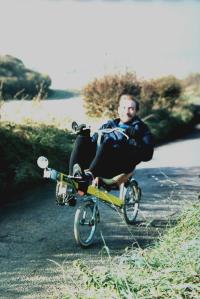
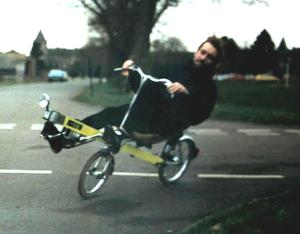
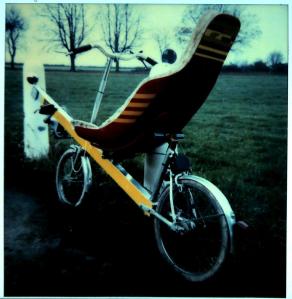



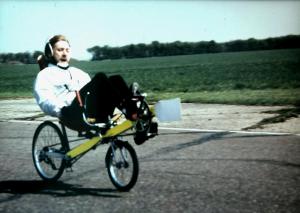
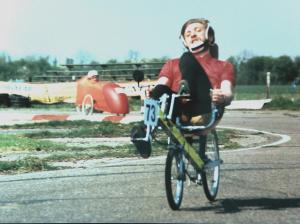

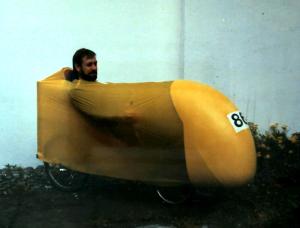








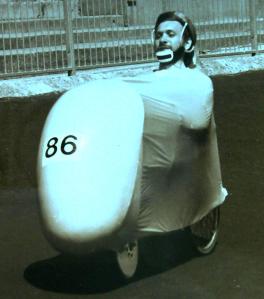














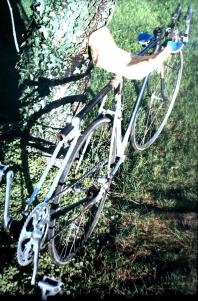



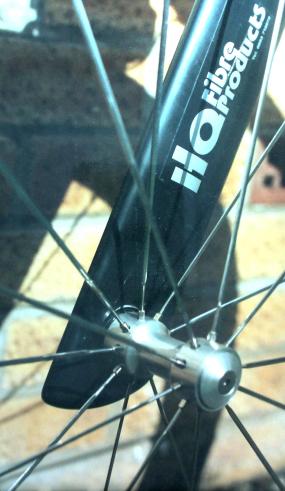






































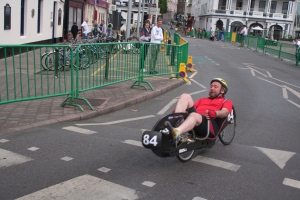











Hi,
Your bike history is fascinating – I still have the Oscar 2 chassis, you probably saw the pictures I took when I was experimenting with the steering geometry. I would happily return it to you – email me when you get a moment
Still waiting to hear back from you about this and the Leaper Not so Low moulds.
yaaaaaaaaaan
Hi there
Long time no see
Hows it going?
You remember me?
I am the spaniard that built LA CUCARACHA (BENT) & THE PANTRIPPER MTB
We raced together many times with Miles, Mike etc….
It`s been nearly 20 years since we have not been in contact
I`m still living in barcelona
Yes I`m HOOSIE
Hi Jose
I remember Jose Espejo and the race events, especially the guy who dropped out of the 25 at Leicester! Yaaaaaan – is that Ian Sheen? Not seen him for a couple of years. Que hace? Apprendido algo de espanol. Tenido una novia en Murcia.
JW
Hi JW
I`m glad that you remember me, but i don`t remember you as JW. Who are you? I`m intreeged .I was trying to get in contact with Ian Sheen through internet & and I thought this web was his.Please can you do me a favour, if you catch up with Yaaaaaan let him know my e-mail. ¿Quién ha aprendido algo de español y ha tenido una novia en Murcia? Tu o Ian Sheen. Ha sido un placer contactar contigo.Gracias y un saludo.
All the best
Hoosie
Soy Jonathan Woolrich. Hablo Espanol. No visto Ian hace un tiempo. No tengo contacto. Lo siento.
Ahora se quien eres.¿Eras tú el que puso el oscar verde que parecía un avion sin alas encima de la furgoneta de Miles y le pegaste muchos papeles para ver el efecto de viento cuando íbamos a una carrera a competir? (Holanda 1995)
He leído tu historia y me parece muy interesante lo que dices.
Eres un crack.
Que te valla muy bien.
Hoosie
Gracias. Si Oscar es lo mio. Encontrado algo Ian aqui http://www.retrobike.co.uk/forum/viewtopic.php?f=1&t=294018 .
Hola JW
¿Todavía compites con tu oscar,o tienes una maquina nueva y mejor?
No té he entendido.(Encontrado algo Ian aquí)
¿Tú sabes algo de yaaaaan, o me preguntas si yo lo he encontrado?
Me pongo en contacto con Legs Larry haber si el sabe algo de el.
Gracias y un saludo
Pruebo en Ingles! I posted a link to a retro bike forum where Ian (Yaaaan) had posted a comment recently. I joined that forum and sent him a hello, but no result. I’m in frequent contact with Legs Larry. He doesn’t have a contact for Ian either. But! it seems I just missed Ian last year. Richard Ballantine died. I was at his memorial but missed the reception. Ian missed the memorial but was at the reception. Also, Mike Burrows tells me Ian turned up at Castle Coombe last year, with new partner on motorbike. Ian and Leila separated some years ago. I have not seen much of him or had a contact since then. I had to look up ‘Ser un crack’. Glad to find it is positive. I have not raced for a few years. The old Oscar was damaged. I have been not building a new version. Meanwhile I built Hocus Pocus, my unfaired which a rode for a few seasons.
Hi there
I`m really grateful for all your efforts trying to find Yaaaan. Sooner or later he will appear (cheers)
What a shame that Richard Ballantine died.I never had the privalage of khowing him personally but had Heard of him lots.
Hey your Hocus Pocus looks cool, is that you on it in the picture?
If you see Mike Burrows give him my regards (Hell of a great guy,another crak)
Gracias,eres un monstruo (I`m sure you`ll look look up)
Hoosie
Try I.sheen@sky.com
Thanks matey. I found the bugger in Facebook
Cheers
Is this the same Ian Sheen whose name is on the certificate in my study as part of the LETA team who got the trike 10 mile team time trial record?
I believe so. I’ve seen those pictures. I saw him earlier this year.
Ian is now on Facebook